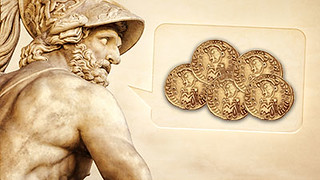
PREV ARTICLE
NEXT ARTICLE
FULL ISSUE
PREV FULL ISSUE
THE PURCHASING POWER OF ANCIENT COINS
Before we leave the topic of ancient coins, I'd like to point out a nice article Mike Markowitz published on November 17, 2015 in
CoinWeek. It's on the topic of the purchasing power of ancient coins. I can't do it justice with a few short excerpts, so
be sure to read the complete version online. -Editor
A meaningful answer must usually begin: “It’s complicated.” A more complete answer might include “It depends…” In our global economy, where almost everything is instantly convertible into cash, we can state precise exchange rates: one US dollar is worth 0.87 euro or 0.95 Swiss francs, or 0.65 British pounds. But what is today’s value of a US dollar in terms of ancient Athenian drachmai, or ancient Roman sestertii? When an ancient Roman had a silver denarius in his purse, what could he buy with it? Ancient economies did not work like modern ones, and ancient writers, almost all slave-owning aristocrats who belonged to privileged elites, rarely wrote about the vulgar topic of money. Bullion Equivalent Value
But “bullion equivalent value” is a very shaky basis for comparing buying power across the centuries. We are comparing gold that was mined with slave labor and refined in charcoal-fired furnaces to gold that is mined with huge diesel-powered shovels and refined with modern physical and chemical methods. In the ancient world, copper alloys (bronze and brass) formed tools, weapons, statues, cooking vessels and countless other non-coinage uses. In our world, copper is a commodity used mainly for electric wiring. Labor Equivalent Value
Soldier’s Pay
Now consider a modern soldier’s pay. A US Army E-2 with less than two years service earns a base pay of $20,808. That would buy over 40 kilograms of silver, or about 555 grams (18.2 troy ounces) of gold at current rates. So in terms of the gold standard, Americans value a foot soldier more than five times as highly as ancient Greeks, and more than eight times as much as ancient Romans did. Summary
Modern currency is primarily “fiat money”, with a value determined by government, while ancient money was largely “commodity money”, with values determined by the supply and demand of precious metals. To read the complete article, see:
Wayne Homren, Editor The Numismatic Bibliomania Society is a non-profit organization promoting numismatic literature. See our web site at coinbooks.org. To submit items for publication in The E-Sylum, write to the Editor at this address: whomren@gmail.com To subscribe go to: https://my.binhost.com/lists/listinfo/esylum All Rights Reserved. NBS Home Page Contact the NBS webmaster 
|
